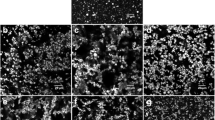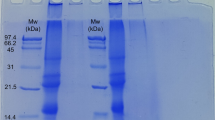Abstract
In this study, effect of using alternative stabilizers based on protein (gelatin ‘A’ and type ‘B’) and polysaccharide hydrocolloids [modified starch and modified gum Arabic (MGA)] was studied using rheological properties of concentrated oil-in-water beverage emulsions. Emulsions were prepared adding 10 g/100 g canola oil into hydrated solutions of 1 g/100 g and 0.75 g/100 g gelatin (type ‘A’ and type ‘B’), and 6 g/100 g and 12 g/100 g modified starch and MGA in buffer solutions at pH 3.4 and 7.0. The choice of pH was based on mimicking acidic fruit-based beverages (pH 3.4) and dairy/milk beverage emulsions (pH 7.0). Emulsions stabilized with gelatin “A” showed a lower flow behavior index (n = 0.85) as compared to gelatin “B” at pH 7.0. However, for polysaccharides stabilized emulsions, unlike protein stabilized emulsions, only slight changes in viscosity and flow behavior indices were noted at elected concentrations. Gelatin stabilized emulsions were more susceptible to pH than modified starch and MGA stabilized emulsions. Gelatin type ‘A’ possessed greater shear thinning features at high pH and showed Newtonian behavior at acidic pH unlike Gelatin type ‘B’ which showed shear thinning behavior at pH 3.4.








Similar content being viewed by others
References
A. Molet-Rodríguez, L. Salvia-Trujillo, O. Martín-Belloso, Beverage emulsions: key aspects of their formulation and physicochemical stability. Beverages 4(3), 70 (2018)
A.R. Taherian, P. Fustier, H.S. Ramaswamy, Effects of added weighting agent and Xanthan gum on stability and rheological properties of beverage cloud emulsions formulated using modified starch. J. Food Process Eng. 30(2), 204–224 (2007)
C. Chung, A. Sher, P. Rousset, D.J. McClements, Impact of oil droplet concentration on the optical, rheological, and stability characteristics of O/W emulsions stabilized with plant-based surfactant: potential application as non-dairy creamers. Food Res. Int. 105, 913–919 (2018)
D.J. McClements, Food emulsions: principles, practices, and techniques (CRC Press, Boca Raton, 2015)
K. Pycia, A. Gryszkin, W. Berski, L. Juszczak, The influence of chemically modified potato maltodextrins on stability and rheological properties of model oil-in-water emulsions. Polymers 10(1), 67 (2018)
D.J. McClements, L. Bai, C. Chung, Recent advances in the utilization of natural emulsifiers to form and stabilize emulsions. Ann. Rev. Food Sci. Technol. 8, 205–236 (2017)
C.P. Tan, Beverage Emulsions. Food Emulsions (Marcel Dekker, Inc, New York, 2004)
R. Chanamai, D.J. McClements, Impact of weighting agents and sucrose on gravitational separation of beverage emulsions. J. Agr. Food Chem. 48(11), 5561–5565 (2000)
A.R. Taherian, P. Fustier, M. Britten, H.S. Ramaswamy, Rheology and stability of beverage emulsions in the presence and absence of weighting agents: a review. Food Biophys. 3(3), 279–286 (2008)
D.I. Comas, J.R. Wagner, M.C. Tomas, Creaming stability of oil in water (O/W) emulsions: Influence of pH on soybean protein-lecithin interaction. Food Hydrocoll. 20(7), 990–996 (2006)
H. Mirhosseini, C.P. Tan, N.S.A. Hamid, S. Yusof, Modeling the relationship between the main emulsion components and stability, viscosity, fluid behavior, zeta-potential, and electrophoretic mobility of orange beverage emulsion using response surface methodology. J. Agric. Food Chem. 55(19), 7659–7666 (2007)
A.M. Spasic, Rheology of Emulsions: Electrohydrodynamics Principles, vol. 22 (Academic Press, Cambridge, MA, 2018)
I. Tavernier, W. Wijaya, P. Van der Meeren, K. Dewettinck, A.R. Patel, Food-grade particles for emulsion stabilization. Trends Food Sci. Technol. 50, 159–174 (2016)
S. Liu, C. Sun, Y. Xue, Y. Gao, Impact of pH, freeze–thaw and thermal sterilization on physicochemical stability of walnut beverage emulsion. Food Chem. 196, 475–485 (2016)
S.H.E. Verkempinck, C. Kyomugasho, L. Salvia-Trujillo, S. Denis, M. Bourgeois, A.M. Van Loey, M.E. Hendrickx, T. Grauwet, Emulsion stabilizing properties of citrus pectin and its interactions with conventional emulsifiers in oil-in-water emulsions. Food Hydrocoll. 85, 144–157 (2018)
E. Dickinson, Hydrocolloids at interfaces and the influence on the properties of dispersed systems. Food Hydrocoll. 17(1), 25–39 (2003)
C. Fantou, S. Comesse, F. Renou, M. Grisel, Hydrophobically modified xanthan: thickening and surface active agent for highly stable oil in water emulsions. Carbohyd. Polym. 205, 362–370 (2019)
H. Mirhosseini, C.P. Tan, N.S.A. Hamid, S. Yusof, Effect of Arabic gum, Xanthan gum and orange oil contents on [zeta]-potential, conductivity, stability, size index and pH oforange beverage emulsion. Colloids Surf. A 315(1–3), 47–56 (2008)
H. Mirhosseini, C.P. Tan, N.S.A. Hamid, S. Yosuf, B.H. Chern, Characterization of the influence of main emulsion components on the physicochemical properties of orange beverage emulsion using response surface methodology. Food Hydrocoll. 23(2), 271–280 (2009)
W. Lan, X. Che, Q. Xu, T. Wang, R. Du, J. Xie et al., Sensory and chemical assessment of silver pomfret (Pampus argenteus) treated with Ginkgo biloba leaf extract treatment during storage in ice. Aquacult. Fish. 3(1), 30–37 (2018)
N. Zhang, W. Lan, Q. Wang, X. Sun, J. Xie, Antibacterial mechanism of Ginkgo biloba leaf extract when applied to Shewanella putrefaciens and Saprophytic staphylococcus. Aquacult. Fish. 3(4), 163–169 (2018)
S. Sabet, C.K. Seal, P.J. Swedlund, D.J. McGillivray, Depositing alginate on the surface of bilayer emulsions. Food Hydrocoll. 100, 105385 (2020)
U. Klinkesorn, P. Sophanodora, P. Chinachoti, D.J. McClements, Stability and rheology of corn oil-in-water emulsions containing maltodextrin. Food Res. Int. 37(9), 851–859 (2004)
Y. Shi, C. Li, L. Zhang, T. Huang, D. Ma, Z.C. Tu et al., Characterization and emulsifying properties of octenyl succinate anhydride modified Acacia seyal gum (gum arabic). Food Hydrocoll. 65, 10–16 (2017)
M. Atgié, A. Chennevière, O. Masbernat, K. Roger, Emulsions stabilized by gum arabic: how diversity and interfacial networking lead to metastability. Langmuir 35(45), 14553–14565 (2019)
R. Chanamai, D.J. McClements, Comparison of gum Arabic, modified starch, and whey protein isolate as emulsifiers: influence of pH, CaCl2 and temperature. J. Food Sci. 67(1), 120–125 (2002)
A. Simancas, F. Molina, M. Murillo, N. Del-Valle, R. Tabla, I. Roa, Biological surface active compounds in dairy industry: preliminary analysis of an emulsifier protein, in Exploring Microorganisms: Recent Advances in Applied Microbiology, ed. by A. Mendez-Vilas (BrownWalker Press, Florida, 2018), p. 125
S. Gorgieva, V. Kokol, Biomaterials applications for nanomedicine (InTech, China, 2011)
T. Huang, Z.C. Tu, X. Shangguan, H. Wang, X. Sha, N. Bansal, Rheological behavior, emulsifying properties and structural characterization of phosphorylated fish gelatin. Food Chem. 246, 428–436 (2018)
M. Ding, T. Zhang, H. Zhang, N. Tao, X. Wang, J. Zhong, Gelatin molecular structures affect behaviors of fish oil-loaded traditional and Pickering emulsions. Food Chem. 309, 125642 (2020)
P. Gharehbeglou, S.M. Jafari, H. Hamishekar, A. Homayouni, H. Mirzaei, Pectin-whey protein complexes vs. small molecule surfactants for stabilization of double nano-emulsions as novel bioactive delivery systems. J Food Eng. 245, 139–148 (2019)
H. Huang, T. Belwal, H. Aalim, L. Li, X. Lin, S. Liu et al., Protein-polysaccharide complex coated W/O/W emulsion as secondary microcapsule for hydrophilic arbutin and hydrophobic coumaric acid. Food Chem. 300, 125171 (2019)
H. Vatankhah, A.R. Taherian, H.S. Ramaswamy, High-pressure induced thermo-viscoelasticity and dynamic rheology of gum Arabic and chitosan aqueous dispersions. LWT 89, 291–298 (2018)
M. Kashaninejad, S.M.A. Razavi, The effects of different gums and their interactions on the rheological properties of instant camel yogurt: a mixture design approach. J. Food Meas. Charact. 13(2), 1299–1309 (2019)
D.D.A. Kamer, I. Palabiyik, N.O. Işık, F. Akyuz, A.S. Demirci, T. Gumus, Effect of confectionery solutes on the rheological properties of fish (Oncorhynchus mykiss) gelatin. LWT 101, 499–505 (2019)
E.M. Ciannamea, L.A. Castillo, R.A. Ruseckaite, S.E. Barbosa, Rheological studies on glycerol plasticized gelatin and its blends with epoxidized soybean oil. J. Renew. Mater. 7(1), 21–30 (2019)
K. Suzuki, T.M.K. Matsouka, K. Kubota, Effect of constituent of rheological properties of corn oil-in-water emulsions. J. Food Sci. 56(3), 796–798 (1991)
M.A. Valdez, J.I. Acedo-Carrillo, A. Rosas-Durazo, J. Lizardi, M. Rinaudo, F.M. Goycoolea, Small-deformation rheology of mesquite gum stabilized oil in water emulsions. Carbohyd. Polym. 64(2), 205–211 (2006)
Acknowledgements
This research was partially supported by the Discovery Grant from the Natural Sciences and Engineering Council (NSERC) of Canada.
Author information
Authors and Affiliations
Corresponding author
Additional information
Publisher's Note
Springer Nature remains neutral with regard to jurisdictional claims in published maps and institutional affiliations.
Rights and permissions
About this article
Cite this article
Ramaswamy, H.S., Arora, J.K., Vatankhah, H. et al. Effect of utilization of alternative hydrocolloid-based stabilizers on rheology of oil-in-water beverage emulsions. Food Measure 14, 1744–1753 (2020). https://doi.org/10.1007/s11694-020-00422-3
Received:
Accepted:
Published:
Issue Date:
DOI: https://doi.org/10.1007/s11694-020-00422-3




